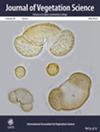Prediction of coastal barren plant species richness and functional diversity by environmental variability across scales
Abstract
Questions
The relationships between environmental heterogeneity and plant diversity may be negative or neutral at fine spatial scales but positive across broader areas. How do the relationships between spatial environmental variability and mean environmental conditions, plant species richness and functional diversity change across spatial scales?
Location
Coastal barrens landscape in Nova Scotia, eastern Canada.
Methods
We sampled plant species composition and environmental variables in nested areas at three scales: 0.25 m2, 1 m2 and 50 m2. At each scale, subsamples of environmental variables (including elevation, soil moisture and depth) were used to calculate average and standard deviation; plant species richness was also determined for each sample. Plant traits at the species level were used to calculate functional dispersion for each of five traits (specific leaf area, leaf dry matter content, leaf thickness, plant height and canopy width) and a combined index of total functional dispersion. Functional dispersion and species richness were predicted at each scale by environmental variables using linear mixed models.
Results
Environmental heterogeneity had low predictive power for plant diversity at the 0.25-m2 scale but was unimodally related to species richness and functional-diversity variables at the 1-m2 scale. The shape of the unimodal relationships suggested a leveling off of diversity at higher levels of environmental variability rather than a decline in diversity (monotonic or asymptotic). There was a strong positive relationship between elevation (topographic) variability and species richness at the 50-m2 scale. Functional dispersion was most strongly related to environmental variables at the 1-m2 scale.
Conclusions
Positive or non-linear asymptotic relationships between environmental heterogeneity, richness and functional diversity at the 1-m2 scale provide some support for niche-based explanations of species coexistence in plant neighborhoods. At broader sampling extents, greater topographic heterogeneity may allow distinct plant communities to co-occur within a sample, increasing richness but not functional diversity because functional diversity in leaf and canopy traits are already high within each plant community.


 求助内容:
求助内容: 应助结果提醒方式:
应助结果提醒方式:


